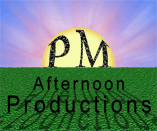A mineral is
- Naturally occurring
- Inorganic
- Definite chemical composition & crystalline structure
- Solid
All physical properties of minerals come from the “internal arrangement of atoms”
Mineral Identification Tests
The Color Test- easiest test to do but not always reliable
The Streak Test
- The color of the powdered mineral.
- Performed by rubbing the unknown mineral on an unglazed tile.
The Luster Test
- the way a mineral shines or doesn't shine
- the only way to really learn the different lusters is to see them for yourself.
Types of Luster
- Metallic- looks like shiney metal
- Non-metallic- all the other ways that a mineral can shine
- Glassy/vitreous- shines like a piece of broken glass (most common non-metallic)
- Dull/earthy- no shine at all
- Resinous/waxy- looks like a piece of plastic or dried glue
- Pearly- looks oily it may have a slight rainbow like an oil slick on water. Also looks like the inside of some clam shells
- Adamantine- brilliant, sparkling shine like a diamond
Hardness- a minerals resistance to scratching. This should not be confused with brittleness. A diamond is very hard and will scratch a hammer but a hammer will smash a diamond. Likewise, talc, one of the softest minerals, is not squishy. It will still put a serious hurting on you if you get hit in the head with it.
Moh’s Scale of Hardness
- Talc (Softest)
- Gypsum
- Calcite
- Fluorite
- Apatite
- Feldspar (AKA Albite)
- Quartz
- Topaz
- Corundum
- Diamond (Hardest)
Key Points of a Hardness Test
- Choose one mineral to be the scratcher and one to be the scratchee.
- Pick a smooth, flat surface to scratch.
- After doing the test, wipe the powder away to confirm that the scratchee really got scratched.
- If the scratchee did not get scratched, switch the two rocks and repeat.
Hardness Tools
- Fingernail 2.5
- Penny 3.5
- Iron Nail 4.5
- Glass Plate 5.5
- Steel File 6.5
- Streak Plate 7
Cleavage -To break along flat surfaces.
Examples of Cleavage
- Cubic- To break into cubes
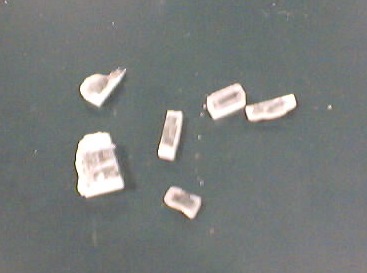
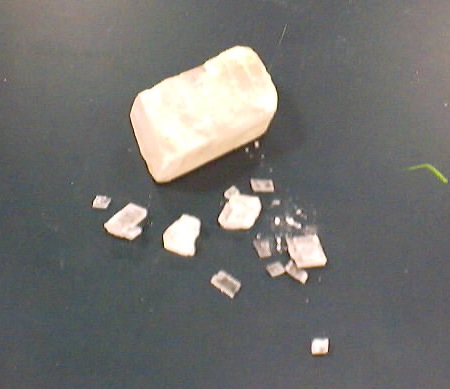
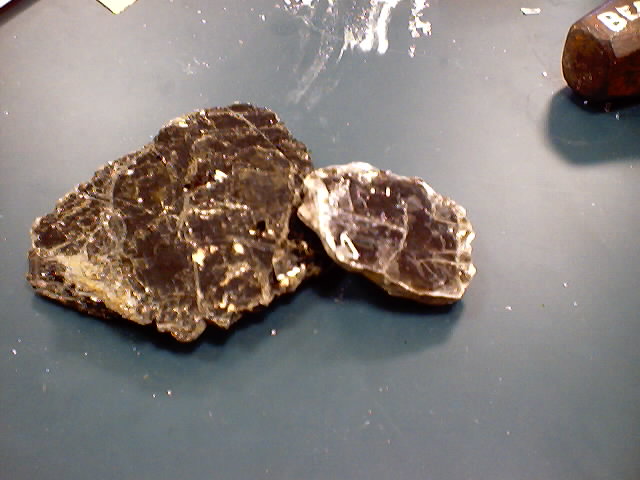
Fracture -The way a mineral without cleavage breaks.
Examples of Fracture
- conchoidal- to break in a scooped out bowl shape- like a conch (sea snail)
- hackly fracture- to have irregular sharp edges
- splintery- to break into long, thin needles
Miscellaneous Tests
- Acid- Calcite and powdered dolomite will effervesce (fizz) in dilute hydrochloric acid (HCl)
- Smell- Sphalerite will give off a rotten-egg smell when streaked on a streak plate. (Note: pure sulfur does not smell like rotten eggs!)
- Magnetism- Magnetite (AKA Lodestone) will pick up paper clips (weak samples will only be able to pick up staples)
- Taste- Halite is rock salt and will taste salty. *Do not taste the samples since some have been tested with acid to see if it is calcite.
- Fluorescence- some minerals (mostly forms of calcite) will glow in fluorescent colors under a black (UV) light.
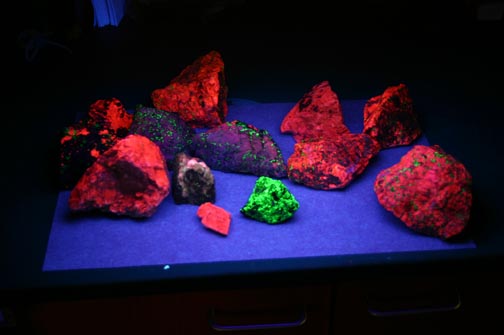
Roll your mouse over to see the change from visible to Fluorescent
- Double refraction- some clear forms of calcite (Iceland Spar) will make a double image of words.
A little about Quartz:
- One of the most abundant minerals in the world (Quartz and feldspar fight for #1)
- Makes beach sand
- Makes glass (melted beach sand)
- Chemical formula: SiO2
- Since it is SiO2, there is twice as much oxygen as silicon.
- According to the Reference Tables pg 11, Oxygen is the #1 element in the crust with Silicon #2 (and about half that of Oxygen)
- Crystal shape is a pyramid called a “tetrahedron”
- Tetra = 4
- hedron =“sided solid
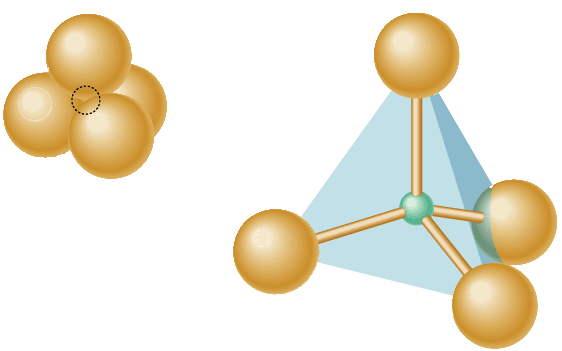
|
Rocks
A rock is a mixture of one or more minerals. They are classified by the way that they are made.
Monominerallic- a rock made of only one mineral. In this case, the rock is both a rock and a mineral.
Polyminerallic- a rock made from more than one mineral.
Rock Cycle
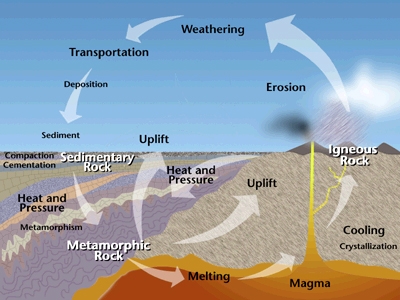
Igneous Rocks
- “Fire Formed”- melted rock material cools and solidifies (“freezing”)
- Intrusive- rock formed inside the Earth
- Extrusive- rock formed on the surface
- Texture- the size of the crystals- NOT HOW IT FEELS
| INtrusive |
Extrusive |
| Rocks INSIDE the Earth |
Rocks OUTSIDE the Earth |
| Plutonic |
Volcanic |
| Formed from magma |
Formed from lava |
| Usually dark |
Usually light colored |
| Usually dense |
Usually low density (light) |
| Mafic: (magnesium and Iron (Fe) |
Felsic: feldspar (aluminum) |
| Cools slowly |
Cools quickly |
| Large grains |
Small or no grains (fine or glassy) |
Igneous rocks have “Intergrown Crystals”
Intergrown...
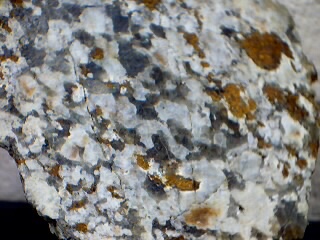
Intergrown...
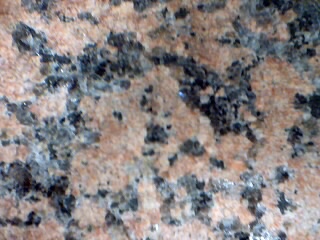
Not Intergrown...
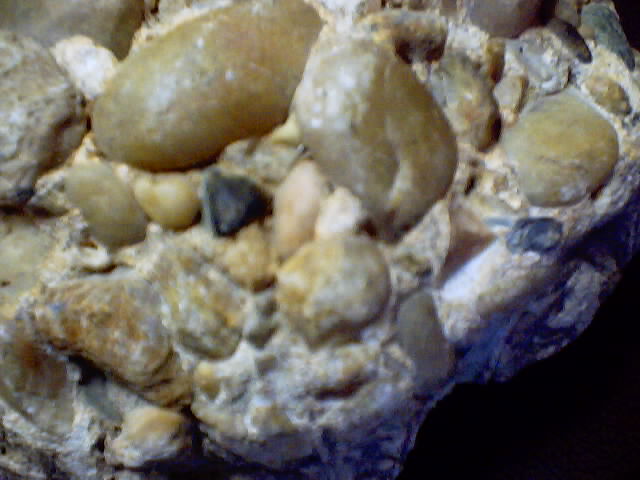
Sedimentary Rocks- Made from sediments or rock material that has been broken down in some way.
- Sedimentary rocks are usually formed in a watery environment.
- Often layered
- Are the only rocks that normally contain fossils
Types of Sedimentary Rocks
- Clastic (fragmental) –made by compaction and cementation of sediments.
- Clastic rocks are identified by the size of the fragments.
- Conglomerate has rounded fragments...

- Breccia has angular fragments...
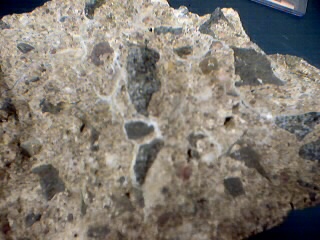
Metamorphic Rocks
- changed from a pre-existing rock
- caused by extreme heat and/or pressure
- may result in a distorted structure like this...
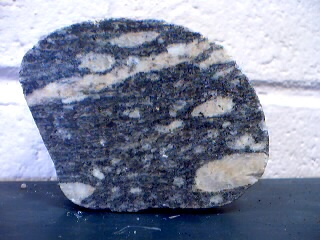
or this...
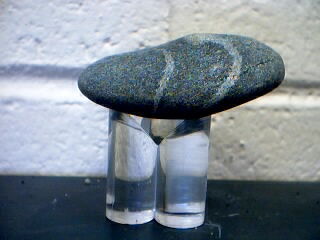
Regional Metamorphism
- Caused by extreme pressure and heat.
- Happens over wide “regions”.
Rocks go from this...
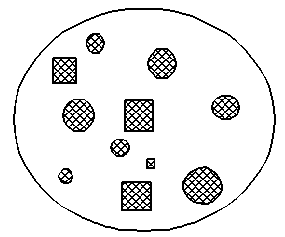
To this...
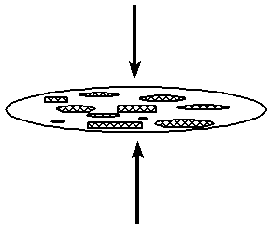
Contact Metamorphism
- Caused by contact with extreme heat.
Metamorphic rocks will often have foliation or a distorted structure.
Foliation is a “grain” to the rock.
Gneissic Foliation
- minerals are squished into bands.
- Zebra Stripes”
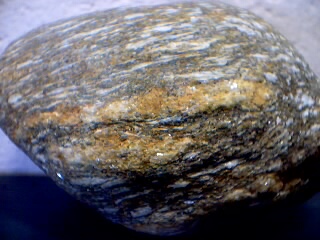
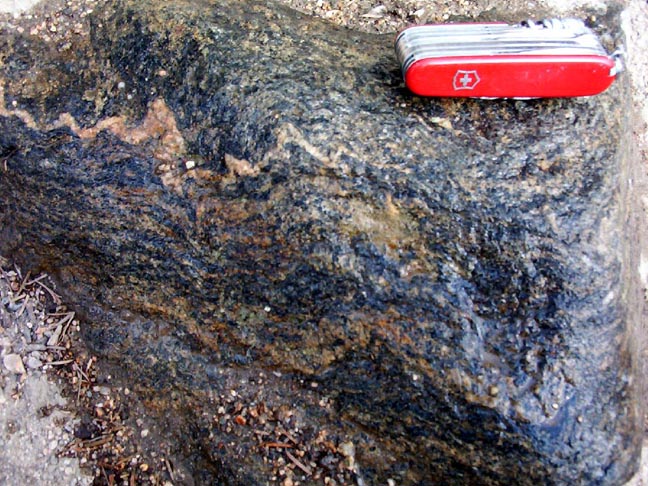
Photo by Phil Medina Colorado 2005
Banding vs. Layers:
Bands do not go all the way through and across your rock. Layers, like in sedimentary rocks go all the way through like a layer in a cake.
Bands...

Layers...
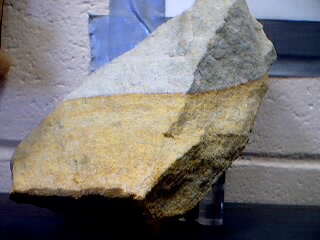
|
Schistose foliation- minerals have been squashed into flakes of mica.
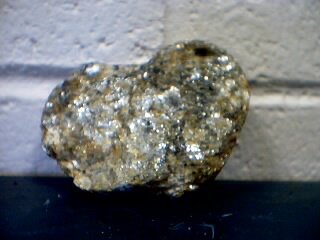
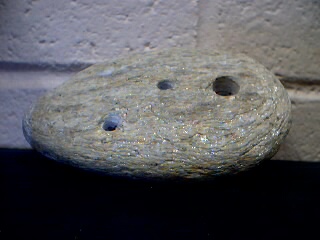
Schist (actually it's holey schist)
Slaty foliation- rock splits into flat, thin layers.
|



















